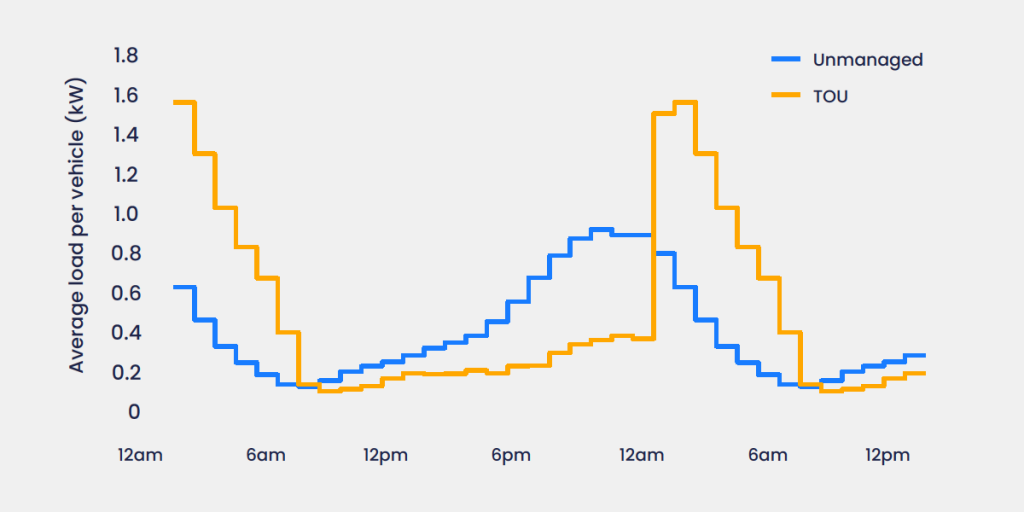
EnergyHub Team
February 13, 2024
This is the third article in EnergyHub’s four-part “Avoiding Gridlock” series on how managed charging can mitigate the distribution impacts of EV charging. Don’t miss part one, The impact of electric vehicles on transmission vs. distribution systems and part two, The distribution impacts of EV charging.
For decades, electric utilities have relied on time-of-use (TOU) rates to shift loads away from periods of high energy use. But as more utility customers opt for electric vehicles (EVs), EV-specific TOU rates may cause more problems than they solve. North America’s bulk grid is relatively well-prepared to deliver the power required to charge EVs en masse. But aging local distribution networks are often not equipped to meet the charging needs of a steadily increasing number of EV drivers in the US and Canada.

At first glance, TOU rates would seem a great way to manage peak loads associated with residential EV charging. And they are a valuable tool today, since they shift load away from peak time periods when expensive power generation is needed to maintain reliability. But TOU rates don’t offer electricity providers the flexibility they’ll need in the medium- to long-term. In fact, studies suggest that TOU rates can increase the risk of thermal overload to distribution network elements by creating an unintended “timer peak” at the conclusion of TOU periods.
EV time-of-use rates put pressure on aging transformers
Time-of-use programs shift peak electric loads that occur at predictable times of day, such as heavy use of air conditioning on hot afternoons, by encouraging customers to move energy use outside the on-peak TOU period. That’s not a problem for most kinds of residential load, but, while charging, electric vehicles draw a lot more power than most household appliances.
When TOU rates are used to manage large numbers of EVs, we take the largest load on the grid – which is naturally diverse and flexible by nature – and synchronize charging times, creating a new, artificial peak. The resulting charging demand from just a handful of EVs hitting the same distribution service transformer simultaneously at the end of a TOU program could result in damage or even failure — a costly problem considering the millions of vulnerable transformers across North America.
TOU rates pose the greatest threat to service transformers still hot from daytime loads. One study found that a TOU-style program that resulted in vehicles charging after midnight would cause service transformers to fail faster than uncontrolled EV charging.

Managed charging mitigates the need for new infrastructure
Managed charging programs shift load dynamically based on real-world charging conditions, preventing timer peaks while meeting evolving grid objectives in real time. As EV adoption continues to grow, managed charging programs are better equipped to manage the risk of transformer failure than TOU-style programs.
Customers who opt in to managed charging programs set a preference to ensure their vehicle is always fully charged by the time they need to leave. If they need a charge right away, they can simply override their “spot” in the charging queue. It’s a user-friendly approach that benefits drivers and utilities as the grid changes to support more renewables and electric vehicles.
Implementing a managed charging program now sets the stage for a reliable, cost-effective transition to a fully-electrified future, while maintaining customer satisfaction and extending the life of aging distribution equipment.
Download our white paper to learn more about how utilities can defer or avoid the need for additional infrastructure by actively managing EV charging load.
Stay tuned: In the next blog in our series, we explore how managed EV charging programs work and their full range of benefits…
Interested in keeping up with the latest dispatch from the grid edge?
Get our next post in your inbox.


